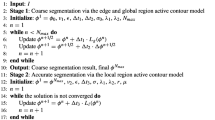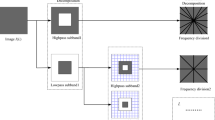Abstract
Subject of this paper is the theoretical analysis of structure-adaptive median filter algorithms that approximate curvature-based PDEs for image filtering and segmentation. These so-called morphological amoeba filters are based on a concept introduced by Lerallut et al. They achieve similar results as the well-known geodesic active contour and self-snakes PDEs. In the present work, the PDE approximated by amoeba active contours is derived for a general geometric situation and general amoeba metric. This PDE is structurally similar but not identical to the geodesic active contour equation. It reproduces the previous PDE approximation results for amoeba median filters as special cases. Furthermore, modifications of the basic amoeba active contour algorithm are analysed that are related to the morphological force terms frequently used with geodesic active contours. Experiments demonstrate the basic behaviour of amoeba active contours and its similarity to geodesic active contours.








Similar content being viewed by others
References
Alvarez, L., Lions, P.L., Morel, J.M.: Image selective smoothing and edge detection by nonlinear diffusion II. SIAM J. Numer. Anal. 29, 845–866 (1992)
Borgefors, G.: Distance transformations in digital images. Comput. Vis. Graph. Image Process. 34, 344–371 (1986)
Caselles, V., Catté, F., Coll, T., Dibos, F.: A geometric model for active contours in image processing. Numerische Mathematik 66, 1–31 (1993)
Caselles, V., Kimmel, R., Sapiro, G.: Geodesic active contours. In: Proceedings of the Fifth International Conference on Computer Vision, IEEE, pp. 694–699. Computer Society Press, Cambridge, MA (1995)
Caselles, V., Kimmel, R., Sapiro, G.: Geodesic active contours. Int. J. Comput. Vis. 22, 61–79 (1997)
Chao, S.M., Tsai, D.M.: An anisotropic diffusion-based defect detection for low-contrast glass substrates. Image Vis. Comput. 26(2), 187–200 (2008)
Cohen, L.D.: On active contours and balloons. Comput. Vis. Graph. Image Process. Image Underst. 53(2), 211–218 (1991)
Cootes, T.F., Taylor, C.J.: Statistical models of appearance for computer vision. Technical report, University of Manchester (2001)
Guichard, F., Morel, J.M.: Partial differential equations and image iterative filtering. In: Duff, I.S., Watson, G.A. (eds.) The State of the Art in Numerical Analysis, no. 63 in IMA Conference Series (New Series), pp. 525–562. Clarendon Press, Oxford (1997)
Holtzman-Gazit, M., Kimmel, R., Peled, N., Goldsher, D.: Segmentation of thin structures in volumetric medical images. IEEE Trans. Image Process. 15(2), 354–363 (2006)
Ikonen, L., Toivanen, P.: Shortest routes on varying height surfaces using gray-level distance transforms. Image Vis. Comput. 23(2), 133–141 (2005)
Kichenassamy, S., Kumar, A., Olver, P., Tannenbaum, A., Yezzi, A.: Gradient flows and geometric active contour models. In: Proceedings of the Fifth International Conference on Computer Vision, pp. 810–815. IEEE Computer Society Press, Cambridge, MA (1995)
Kichenassamy, S., Kumar, A., Olver, P., Tannenbaum, A., Yezzi, A.: Conformal curvature flows: from phase transitions to active vision. Arch. Ration. Mech. Anal. 134, 275–301 (1996)
Kimmel, R.: Fast edge integration. In: Osher, S., Paragios, N. (eds.) Geometric Level Set Methods in Imaging, Vision and Graphics, pp. 59–77. Springer, New York (2003)
Lerallut, R., Decencière, E., Meyer, F.: Image processing using morphological amoebas. In: Ronse, C., Najman, L., Decencière, E. (eds.) Mathematical Morphology: 40 Years On, Computational Imaging and Vision, vol. 30. Springer, Dordrecht (2005)
Lerallut, R., Decencière, E., Meyer, F.: Image filtering using morphological amoebas. Image Vis. Comput. 25(4), 395–404 (2007)
Leventon, M.E., Grimson, W.E.L., Faugeras, O.: Statistical shape influence in geodesic active contours. In: Proceedings of the 2000 IEEE International Conference on Computer Vision and Pattern Recognition, vol. 1, pp. 316–323. Hilton Head Island, CA (2000)
Malladi, R., Sethian, J., Vemuri, B.: Shape modeling with front propagation: a level set approach. IEEE Trans. Pattern Anal. Mach. Intell. 17, 158–175 (1995)
Maragos, P.: Overview of adaptive morphology: trends and perspectives. In: Proceedings of the 2009 IEEE International Conference on Image Processing, pp. 2241–2244. Cairo, Egypt (2009)
Osher, S., Sethian, J.A.: Fronts propagating with curvature-dependent speed: Algorithms based on Hamilton–Jacobi formulations. J. Comput. Phys. 79, 12–49 (1988)
Perona, P., Malik, J.: Scale space and edge detection using anisotropic diffusion. IEEE Trans. Pattern Anal. Mach. Intell. 12, 629–639 (1990)
Sapiro, G.: Vector (self) snakes: a geometric framework for color, texture and multiscale image segmentation. In: Proceedings of the 1996 IEEE International Conference on Image Processing, vol. 1, pp. 817–820. IEEE, Lausanne (1996)
Spira, A., Kimmel, R., Sochen, N.: A short-time Beltrami kernel for smoothing images and manifolds. IEEE Trans. Image Process. 16(6), 1628–1636 (2007)
Tukey, J.W.: Exploratory Data Analysis. Addison-Wesley, Menlo Park (1971)
Welk, M.: Amoeba active contours. In: Bruckstein, A.M., ter Haar Romeny, B., Bronstein, A.M., Bronstein, M.M. (eds.) Scale Space and Variational Methods in Computer Vision, Lecture Notes in Computer Science, vol. 6667, pp. 374–385. Springer, Berlin (2012)
Welk, M.: Relations between amoeba median algorithms and curvature-based PDEs. In: Kuijper, A., Pock, T., Bredies, K., Bischof, H. (eds.) Scale Space and Variational Methods in Computer Vision, Lecture Notes in Computer Science, vol. 7893, pp. 392–403. Springer, Berlin (2013)
Welk, M., Breuß, M., Vogel, O.: Morphological amoebas are self-snakes. J. Math. Imag. Vis. 39, 87–99 (2011)
Author information
Authors and Affiliations
Corresponding author
Appendix: Details of Proofs
Appendix: Details of Proofs
1.1 Proof of Corollary 2
For the \(L^1\) amoeba norm, one has \(\nu (s)=1+|s|\), thus \(\nu '(s)=\mathrm {sgn}\,s\). Inserting these into (5) yields
where we have assumed without loss of generality \(\alpha \in [0,\pi ]\). Evaluating the indefinite integrals
and
at the integration boundaries \(\pm (\pi /2-\alpha )\) and inserting \(\tan \left( \frac{\pi }{4}-\frac{\alpha }{2}\right) =\frac{\cos \alpha }{1+\sin \alpha }\) yields (27), (29) and (31). The proof for \(\alpha \in [-\pi ,0]\) is analogous but the integral is split for the \(\mathrm {sgn}\,\cos \vartheta \) factor at \(-\pi /2\), finally leading to integration boundaries \(\pm (\pi /2+\alpha )\). As a consequence, all instances of \(\sin \alpha \) are replaced with \(-\sin \alpha \), which is subsumed by the use of \(|\sin \alpha |\) in (27), (29) and (31). Analogously, one has for \(\alpha \in [0,\pi ]\)
which is evaluated via the indefinite integrals
to obtain (28), (30) and (32). As before, the inclusion of the case \(\alpha \in [-\pi ,0]\) implies the use of \(|\sin \alpha |\) in all three equations. Finally, one has for \(J_2\) and \(\alpha \in [0,\pi ]\)
and the indefinite integral
from which (26) is obtained in a straightforward way. As before, the case \(\alpha \in [-\pi ,0]\) is subsumed by inserting modulus bars around \(\sin \alpha \).
1.2 Relation between \(\tilde{J}_1\) and \(\tilde{J}_3\)
To complete the proof of Corollary 3, we show that \(h(s)=s\,g'(s)\). We notice first that
where the last summand is essentially the integrand of \(\tilde{J}_1(\beta \,s)\). By integration it follows that
Substituting this into (34) yields
from which one easily calculates
1.3 Equivalence of Corollary 3 to the Result from [27]
In [27] it was shown that iterated amoeba median filtering approximates the PDE (4) as in Corollary 3 with the edge-stopping function \(g\) given by
where the function \(\psi \) is related to \(\nu \) via
and \(\psi ^{-1}\) denotes the inverse function of \(\psi \). Substituting
into \(I_1\) yields
where the inverse function has been cancelled due to \(\psi ^{-1}\circ \psi \equiv \mathrm {id}\). Inserting this into (76) and rewriting \(\psi \) into \(\nu \) via (78) and
gives
Integration by parts using (72) gives for the first summand
and after reordering of terms and division by \(3/2\)
Making once more use of (72), we calculate
Substituting (85) and (86) into (83) eventually leads to
in accordance with the representation from Corollary 3. This completes the proof.
Rights and permissions
About this article
Cite this article
Welk, M. Analysis of Amoeba Active Contours. J Math Imaging Vis 52, 37–54 (2015). https://doi.org/10.1007/s10851-014-0524-1
Received:
Accepted:
Published:
Issue Date:
DOI: https://doi.org/10.1007/s10851-014-0524-1




